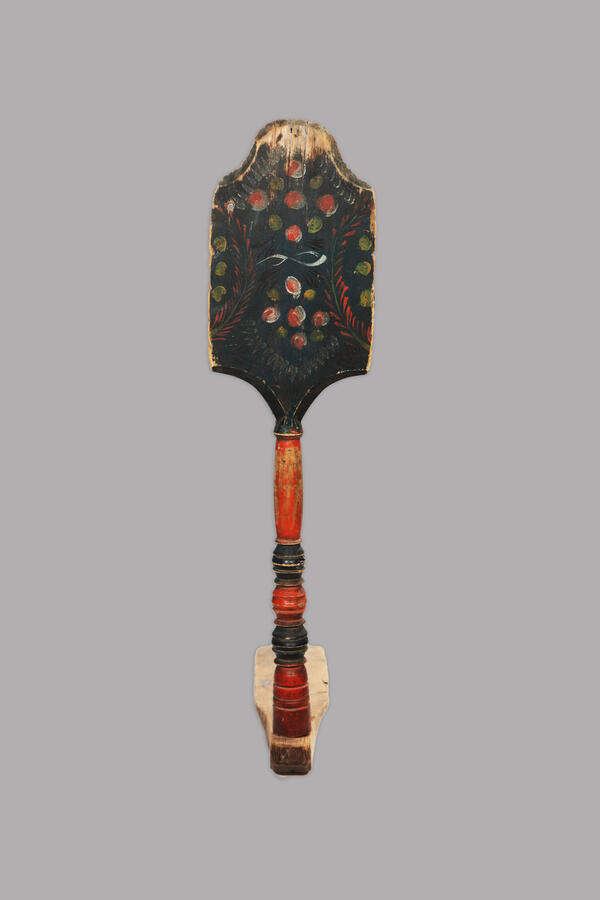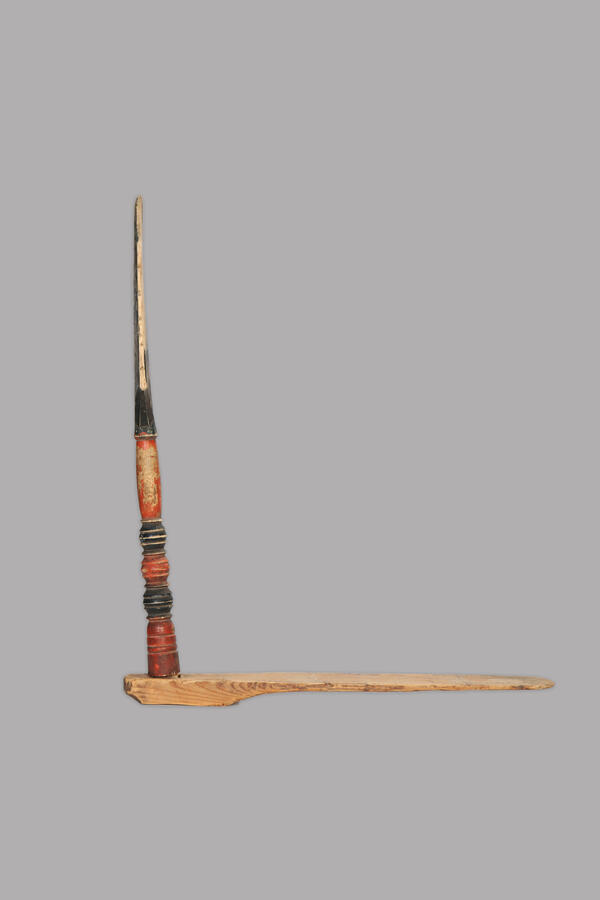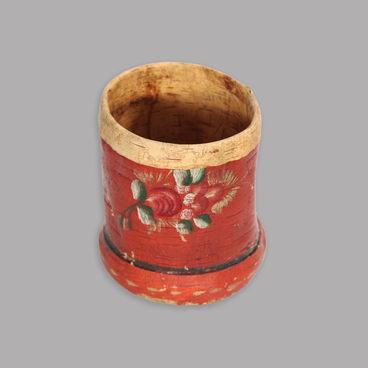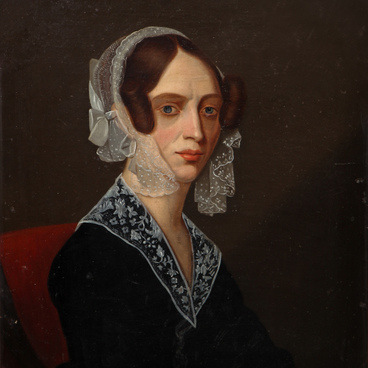A traditional Russian L-shaped distaff, displayed in the Komi-Permyak Museum, consists of a base, leg and a blade. The base is where the spinner sits while working, and the blade is the part where cleaned and processed wool or flax fibers were attached. The figured base of the distaff is turned on a lathe, the blade is decorated with a pattern on both sides. Presumably, it is a work by Kungur craftsmen.
In terms of artistic design, it is an imitation of Obvinsky wood-painting, a folk craft of the Urals. The blade of the distaff features two flowers in a simplified stylized form. Each of them has eight petals, like the “Obvinsky rose”, the most characteristic element of the Obvinsky painting. It is also suggested by the fluffy stems, ears of crops, and the drawing manner. It is made in the Obvinsky “razbel” technique, when the artist simultaneously puts whitewash and the main color on the brush, so that the stroke looks voluminous, smooth and with a white flare on one side.
The base of the distaff is painted with the same orange and blue tones as the main pattern. The technology of painting a colorful design is very simple and distinctive. In Kungur painting, cold tones were preferred, with dark blues, blues and greens prevailing in the background colors. Paints were made locally from natural minerals, rubbing and mixing them with linseed oil. The first step was to determine the size of the motif and composition, then underpainting marked the main spots of flowers, buds, leaves. By dipping a brush in the paint of the desired color and rotating it around its axis, masters in one movement turned the under-image into a ripe berry or a petal.
Distaffs appeared in the first millennium AD, following the invention of the hand spindle. In terms of their construction, they are divided into one-piece, made from the root or trunk of a tree, and assembled ones, consisting of two parts. Simple distaffs used to stand in a peasant’s home. One woman could have several tools. Ural masters, who worked on the creation of festive and ceremonial distaffs, developed various designs for each region and purpose of the distaff. On a child’s distaff a newly fledged chick was drawn, and on a young girl’s distaff there were two pretty birds. A beautiful distaff served as a means of presenting the girl, indicating the prosperity in her family, and complementing her festive dress.
In terms of artistic design, it is an imitation of Obvinsky wood-painting, a folk craft of the Urals. The blade of the distaff features two flowers in a simplified stylized form. Each of them has eight petals, like the “Obvinsky rose”, the most characteristic element of the Obvinsky painting. It is also suggested by the fluffy stems, ears of crops, and the drawing manner. It is made in the Obvinsky “razbel” technique, when the artist simultaneously puts whitewash and the main color on the brush, so that the stroke looks voluminous, smooth and with a white flare on one side.
The base of the distaff is painted with the same orange and blue tones as the main pattern. The technology of painting a colorful design is very simple and distinctive. In Kungur painting, cold tones were preferred, with dark blues, blues and greens prevailing in the background colors. Paints were made locally from natural minerals, rubbing and mixing them with linseed oil. The first step was to determine the size of the motif and composition, then underpainting marked the main spots of flowers, buds, leaves. By dipping a brush in the paint of the desired color and rotating it around its axis, masters in one movement turned the under-image into a ripe berry or a petal.
Distaffs appeared in the first millennium AD, following the invention of the hand spindle. In terms of their construction, they are divided into one-piece, made from the root or trunk of a tree, and assembled ones, consisting of two parts. Simple distaffs used to stand in a peasant’s home. One woman could have several tools. Ural masters, who worked on the creation of festive and ceremonial distaffs, developed various designs for each region and purpose of the distaff. On a child’s distaff a newly fledged chick was drawn, and on a young girl’s distaff there were two pretty birds. A beautiful distaff served as a means of presenting the girl, indicating the prosperity in her family, and complementing her festive dress.





